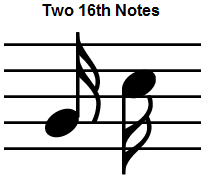 Let’s take a look at sixteenth notes. These are notes which have one sixteenth the time value of whole notes. In other words, it takes sixteen of them to make up a whole note. In Britain and other countries, this note is also called a semiquaver.
Let’s take a look at sixteenth notes. These are notes which have one sixteenth the time value of whole notes. In other words, it takes sixteen of them to make up a whole note. In Britain and other countries, this note is also called a semiquaver.
My #1 Recommendation: Go here to learn about the BEST piano/keyboard course I’ve seen online.
A 16th note is very short, in terms of its time value. It is played for half the duration of an eighth note (quaver), hence the name, semiquaver which means half a quaver.
Sixteenth notes (semiquavers) are notated with an oval, filled-in note head. They have a straight stem and two flags. (They look almost like eighth notes, except that eighth notes have one flag). Like other notes with stems, when 16th notes are below the middle line of the staff, the stems are drawn to the right of the notehead facing up. If the notes are on or above the middle line, the notes are drawn with stems on the left of the notehead, facing down.
The flags are always on the right side of the stem. Flags curve to the right. If the stems face up, the flags start at the top and curve down. If the stems face downwards, the flags start at the bottom of the stem and curve up.
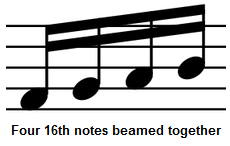 What happens when there are multiple sixteenth notes next to each other? In such a situation the flags may be connected with what is called a beam. The picture below shows 16th notes beamed together. Eighth notes may also be beamed together like this, as well as 32nd notes and 64th notes.
What happens when there are multiple sixteenth notes next to each other? In such a situation the flags may be connected with what is called a beam. The picture below shows 16th notes beamed together. Eighth notes may also be beamed together like this, as well as 32nd notes and 64th notes.
How many 16th notes in an eighth note? Answer is 2.
How many in a quarter note? Answer is 4.
How many in a half note? Answer is 8.
How many in a whole note? Answer is sixteen.
How to Count Sixteenth Notes
When counting rhythms with 16th notes, the words normally used for the subdivisions are “one e and a”. “E” is pronounced like the letter, “e”, while “a” is pronounced like the syllable “uh”. “E and a” is counted after every beat. This helps you maintain a stead tempo and play accurately. We say “1 e and a 2 e and a 3 e and a 4 e and a”. The “and” in each of the beats happen at the same time as the “and” when counting 8th notes.
“One e and a” and so on is a way of dividing each beat in four. Each note is held for a quarter of a beat. You can use a metronome to practice this. Set your metronome on 60 and keep repeating “1 e and a 2 e and a 3 e and a 4 e and a”. “One, two, three, and four” fall directly on the beat.
If we were counting eighth notes we would count “1 and 2 and 3 and 4 and”. Each beat is divided in two.
If we were counting quarter notes, it would be “1, 2, 3, 4”. There is no subdivision.
Sixteenth notes, as we’ve seen, receive a 1/4 of a count, but they usually appear in one of 6 different patterns. Let’s take a look at these patterns in the diagram below. 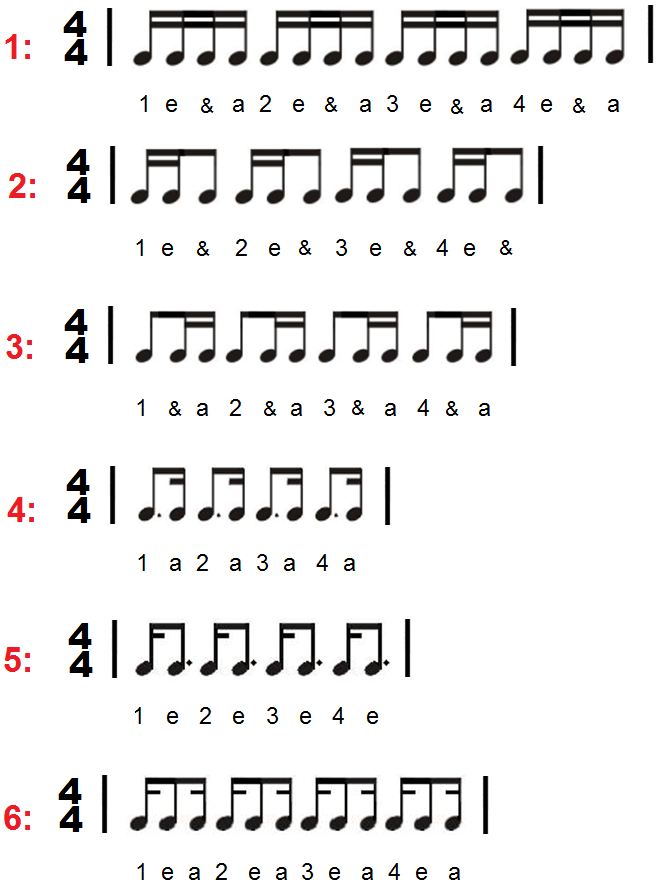
In the first pattern, we count “1 e and a 2 e and a 3 e and a 4 e and a”. In the second pattern, it’s ” 1 e and 2 e and 3 e and 4 e and. In the third pattern, count “1 and a 2 and a 3 and a 4 and a.” For pattern four, count “1 a 2 a 3 a 4 a.” For pattern five, count ” 1 e 2 e 3 e 4 e”. And for the sixth pattern, count “1 e a 2 e a 3 e a 4 e a”. Practice these various patterns. It will really help.
Here are a few exercises. They include sixteenth, eighth and quarter notes. Set your metronome and practice counting these notes. 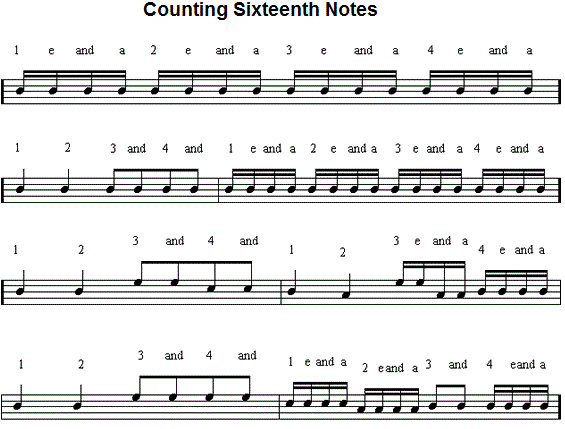
Counting 8th and 16th notes (Video):
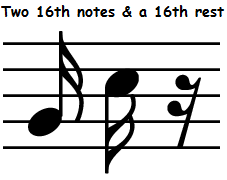 A sixteenth note has the same time duration as a sixteenth rest(semiquaver rest). It simply means that you are to play nothing for a quarter of a beat. A sixteenth rest has 1/16 the duration of a whole rest.
A sixteenth note has the same time duration as a sixteenth rest(semiquaver rest). It simply means that you are to play nothing for a quarter of a beat. A sixteenth rest has 1/16 the duration of a whole rest.
Piano notes and keys – Learn the notes which correspond to the keys on the piano. Learn about other type of notes: quarter, half and eighth notes. Lots more.